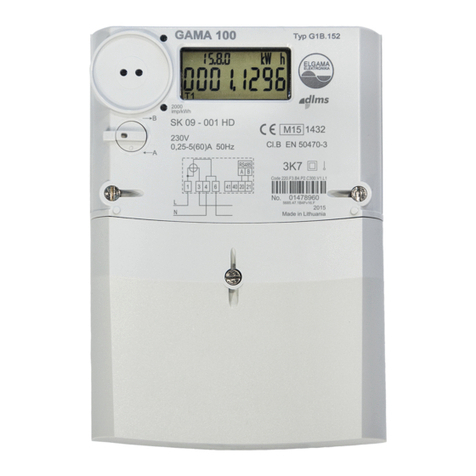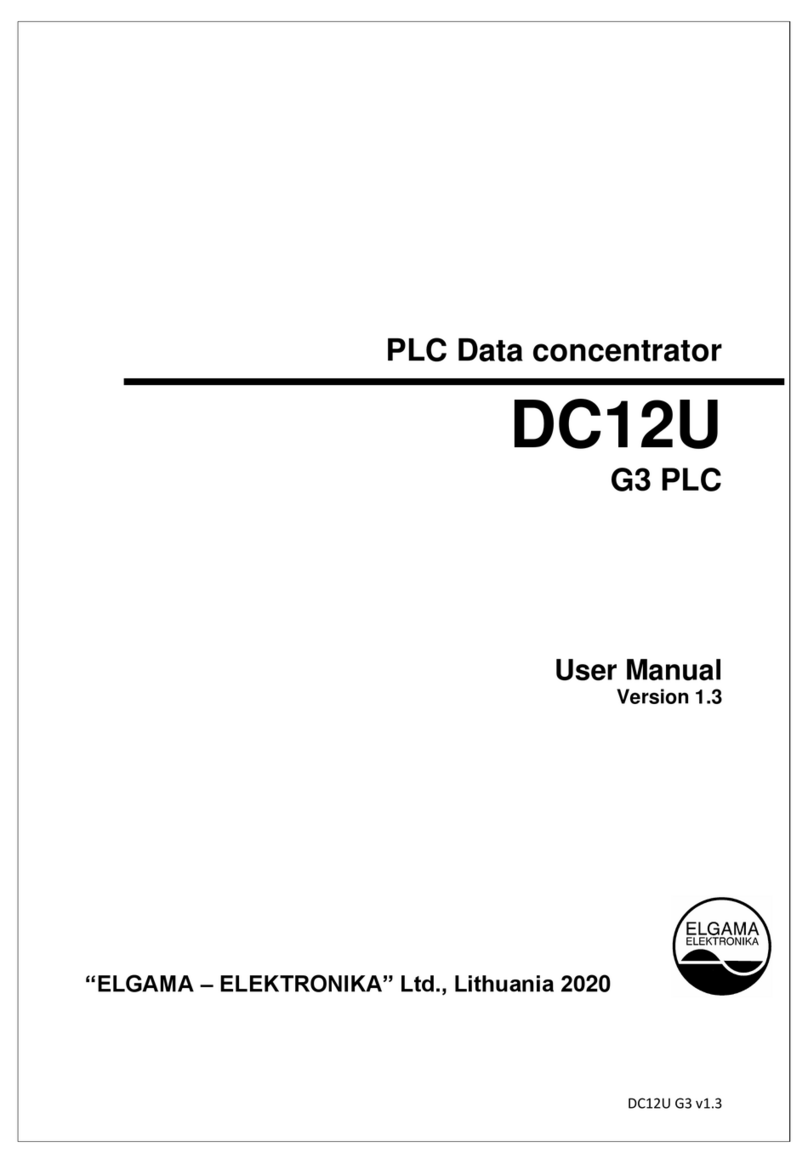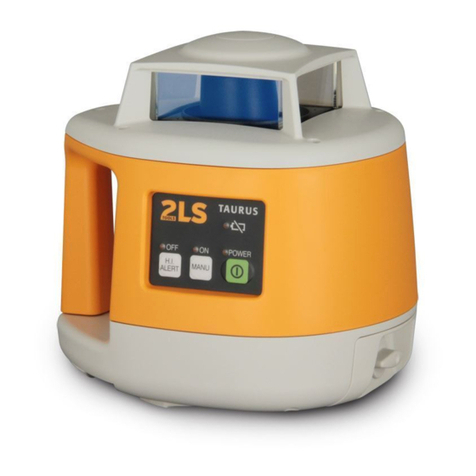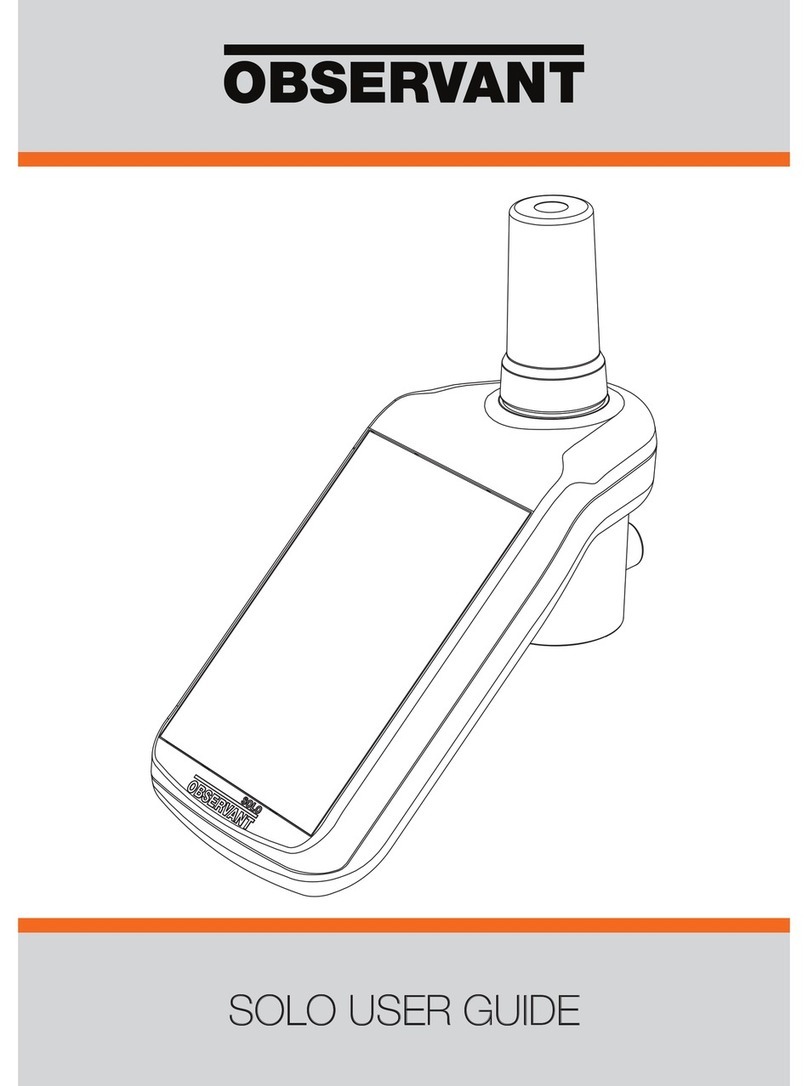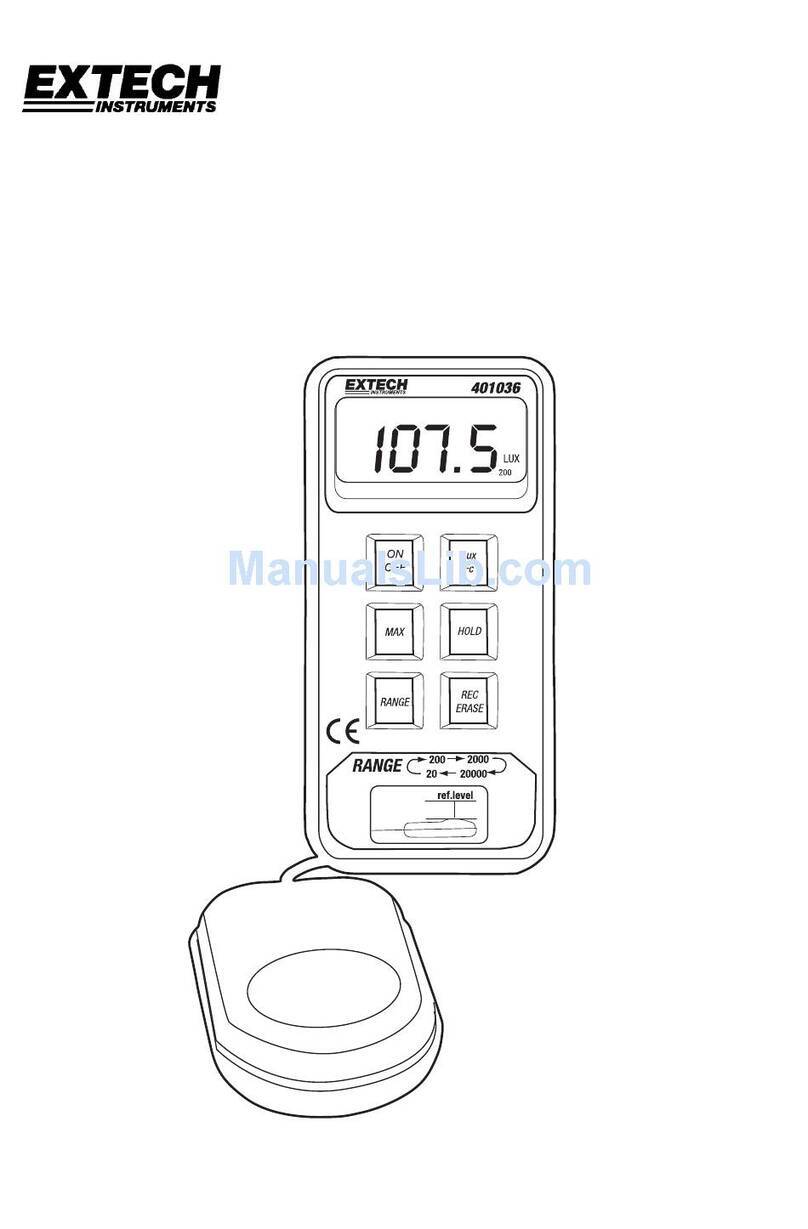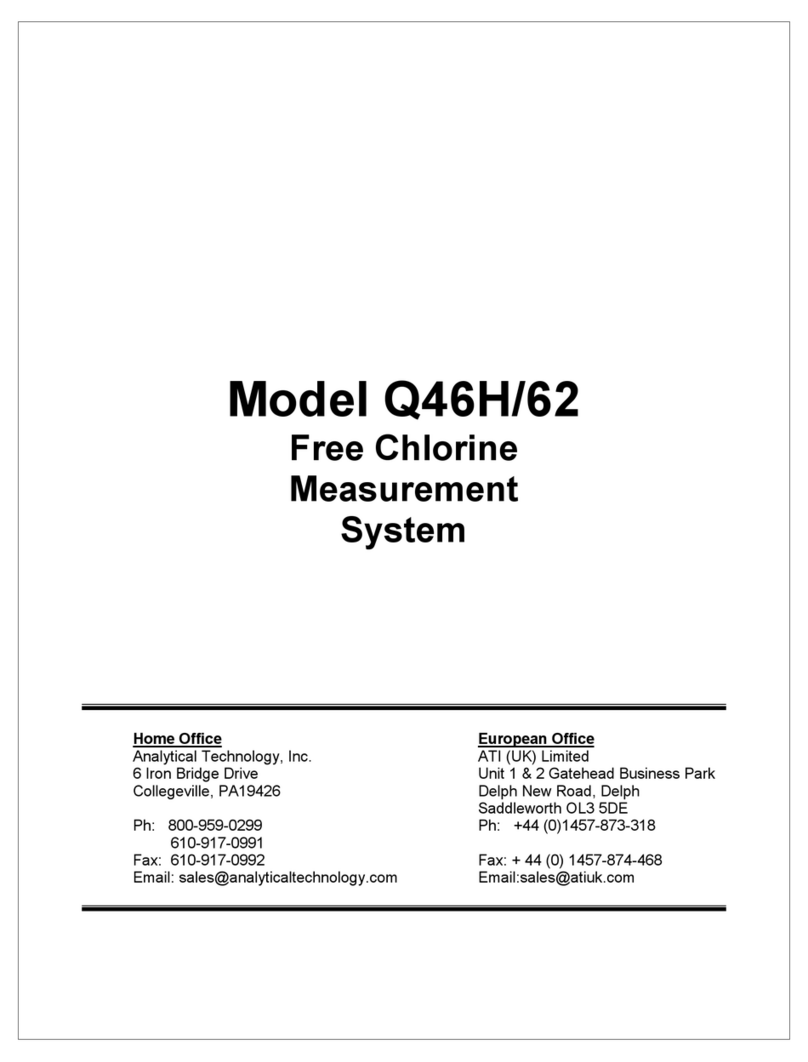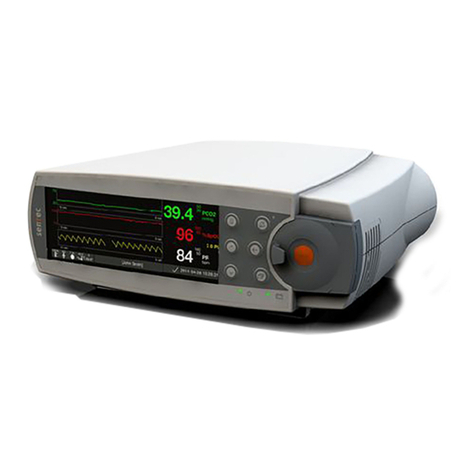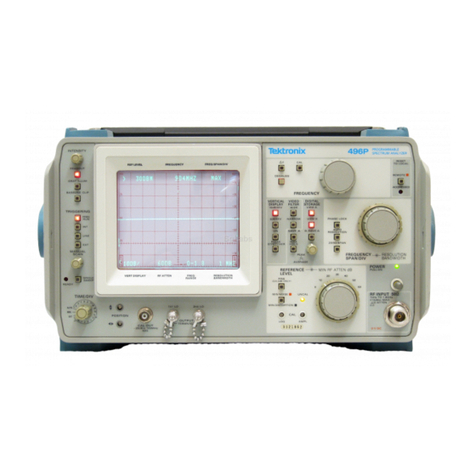Elgama EPQS User manual

Multifunction Meter of
active, reactive and apparent Electric Energy
EPQS
User Manual
Version 5.2a
(PQSEN52a)
“ELGAMA – ELEKTRONIKA”, Lithuania 2017


3
“ELGAMA-ELEKTRONIKA”
EPQS
Multifunction Meter of Active, Reactive and
Apparent Electric Energy
User Manual
"ELGAMA-ELEKTRONIKA" Ltd.
Visoriu str. 2,
LT-08300 Vilnius
Lithuania
Tel. 8 5 2375 000
Fax. 8 5 2375020
e-mail: info@elgama.eu

4
This user manual describes the electronic multifunction EPQS meter of electric energy and the use of
the meter. Please read this document carefully before installing and using the meter. The
manufacturer’s warranty shall not apply if the meter is damaged as a result of failure to comply with
the requirements described in this manual or registration certificate or those of work safety.
The manufacturer shall not be held liable for any kind of loss incurred by the meter parameterization
performed not following instructions described in the users program as well as recommendations and
State-defined tariffs. The manufacturer shall be not held liable for any damage related to partial or
total data loss due to unprofessional actions of authorized persons.
This user manual describes all possible features, functions, and auxiliary outputs of the electrical
energy meter. Your meter might not have some features, functions, or auxiliary outputs described in
this document. The exact configuration, features, accessories, and connection diagram of the meter is
provided in its registration certificate.

5
Table of Contents
1. PURPOSE AND FEATURES...........................................................................................................6
1.1. MARKING OF METER MODIFICATIONS................................................................................................................7
1.2. TECHNICAL SPECIFICATIONS............................................................................................................................8
2. DESIGN...........................................................................................................................................9
2.1. CASE .............................................................................................................................................................9
2.2. GENERAL REQUIREMENTS AND INSTALLATION PROCEDURE ............................................................................10
2.3. ELECTRONIC CIRCUITRY AND PRINCIPLES OF OPERATION ................................................................................12
2.3.1. Measurement module .........................................................................................................................12
2.3.2. Analog to Digital Signal Conversion ...................................................................................................12
2.3.3. Central Processor Unit........................................................................................................................12
2.3.4. Non-volatile RAM Unit.........................................................................................................................13
2.3.5. Internal Clock......................................................................................................................................13
2.3.6. Liquid Crystal Display (LCD)...............................................................................................................13
2.4. COMMUNICATION INTERFACES.......................................................................................................................14
2.4.1. Optical Interface (D0)..........................................................................................................................14
2.4.2. Electrical communication Interface.....................................................................................................14
2.4.3. Auxiliary Communication Interface (optional).....................................................................................14
2.4.4. Interface Priorities...............................................................................................................................14
2.5. THE METER INPUTS AND OUTPUTS ................................................................................................................14
2.5.1. Optical LED Output (Red Light Emission Diodes)..............................................................................14
2.5.2. Pulse Output contacts.........................................................................................................................15
2.5.3. Relay Outputs (Optional) ....................................................................................................................15
2.5.4. External Backup Power Supply (optional) ..........................................................................................16
2.6. POWER SUPPLY............................................................................................................................................16
2.7. PUSH BUTTON..............................................................................................................................................16
3. DATA REGISTRATION..................................................................................................................16
3.1. ENERGY REGISTRATION................................................................................................................................18
3.2. DEMAND REGISTRATION ................................................................................................................................19
3.3. REGISTRATION OF INSTANTANEOUS VALUES ..................................................................................................19
3.4. POWER QUALITY REGISTRATION....................................................................................................................21
3.5. “END OF BILLING PERIOD”..............................................................................................................................22
4. TARIFF MODULE..........................................................................................................................23
4.1. DAY PROGRAM..............................................................................................................................................23
4.2.WEEK PROGRAM...........................................................................................................................................23
4.3. TARIFF SEASONS..........................................................................................................................................23
4.4. SPECIAL DAYS ..............................................................................................................................................24
4.5. TARIFF MODULE OPERATION IN CASE OF CLOCK FAILURE ..............................................................................24
5. DATA DISPLAY MODES...............................................................................................................25
5.1. AUTOMATIC CYCLIC DATA INDICATION MODE .................................................................................................25
5.2. STATIC DATA INDICATION MODE....................................................................................................................25
5.3. DATA REVIEW ALGORITHMS ..........................................................................................................................25
6. PARAMETERISATION ..................................................................................................................27
7. METER DATA PROTECTION........................................................................................................28
7.1. PHYSICAL PROTECTION OF DATA AND PARAMETERS.......................................................................................28
7.2. SOFTWARE PROTECTION...............................................................................................................................28
7.2.1. Password ............................................................................................................................................28
7.2.2. Lock of optical interface (optional)......................................................................................................28
7.2.3. Event logbook .....................................................................................................................................28
7.2.4. Counters and Timers ..........................................................................................................................29
7.2.5. Protection of Factory Constants .........................................................................................................29
ANNEX A. DATA AVAILABLE TO DISPLAY ON LCD........................................................................30

6
1. Purpose and Features
The EPQS meter is a multifunction device for measurement of electric energy. CT operated meters
comply with requirements of IEC 62053-22 standard, class 0,5 or 0,2s.
The meter data structure is compatible with DLMS standard. Each measured parameter has its OBIS
(OBject Identification System) code describing the parameter or value. OBIS codes together with
allocated parameters are transmitted through the communication interfaces and displayed on the
meter LCD display screen.
The meter measures, registers, and collects data on active energy of both directions (+A, -A), reactive
energy of both directions (+R, -R), reactive energy in four quadrants (R1, R2, R3, R4), and apparent
energy of both directions (+W, -W). The meter also registers maximums of average power, collects
load profiles and registers cumulative powers.
Besides the aforementioned values, the EPQS meter can display or transmit via its communication
interfaces the following profiles stored in any of 16 freely programmed channels: phase and line
voltages; currents; instantaneous active, reactive, and apparent power; frequency; power factor (cos
). It can also analyze power quality and generate weekly reports of power grid quality.
Up to eight of energy and the same number of power maximum tariffs can be activated for tariffication
of energy and power. The structure of tariff module lets adapt the meter for virtually any of existing
tariff program.
For remote data transmission, the meter has two independent electrical communication interfaces.
For local data readout, optical interface D0 is provided.
Several modifications of EPQS meter are manufactured. They may differ in nominal current, voltage,
connection type, and the meter hardware or software. The designation of different modifications of
EPQS meter is explained in Table 1-1.

7
1.1. Marking of meter modifications
Table 1-1. Explanation of meter modification code
EPQS
X
X
X.
XX.
XX
Measuring elements:
3 elements, 4 –wire connection
1
Rated voltage, V:
3x57,7/100; 3x63,5/110; 3x69,2/120; 3x100; 3x110;
3x120
1
multi range (3x57,7 ...230/100 ...400)
2
3x220/380; 3x230/400; 3x380; 3x400
3
3x120/208; 3x127/220; 3x220; 3x230
4
Rated (maximal) current, A:
CT connection 5(6,25)
1
CT connection 5(10)
2
CT connection 1(2), 1(1,25)
3
CT connection 1(6)
4
5
Software code:
Hardware code:
Hardware of class 0.2s
2X

8
1.2. Technical Specifications
Accuracy class:
CT operated
0.2s or 0.5s (IEC 62053-22)
Rated voltage, V
see table 1-1
Rated (maximum) current, A
see table 1-1
Rated frequency, Hz
50 or 60
Sensitivity threshold, %Inom
CT operated
0,1
Power consumption, VA
in voltage circuits
< 3 (0,76W)
in current circuits
< 0,5/phase (CT operated)
Meter constant, imp/kWh
130000
Communication interfaces:
optical interface D0
IEC 62056-21
electrical interface I
IEC 62056-31
electrical interface II
IEC 62056-31
pulse outputs:
number:
6 (independent)
output constant, imp/kWh (imp/kVArh):
130000
pulse duration, ms
30
External backup power supply:
= 12V
Tariff module:
number of energy tariffs:
programmable (1 … 8)
number of maximum demand tariffs:
programmable (1 … 8)
Data storage without power supply:
20 years (t=20°C);
2 years (t=60°С)
Backup supply of internal clock:
Li battery
Battery resource for not connected meter
> 5 years
Insulation:
pulse voltage test (IEC 60060-1)
6kV
alternating voltage test
4kV
Operating temperatures
-40°C … +60°C
Storage and transportation temperatures
-50°C … +70°C
Weight, Kg:
< 1,5
Dimensions, mm
325 x 177 x 55

9
2. Design
2.1. Case
Picture 2-1 presents the external view of the device.
Picture 2-1. Meter exterior
1
Transparent cover
6
Optical communication interface;
2
Sealed screws;
7
Terminal block cover
3
Meter panel;
8
Button
4
Liquid Crystal Display;
9
Light emitting diode (LED) 1;
5
Display control photo sensor
10
Light emitting diode (LED) 2;
The meter panel is covered by transparent cover moulded from UV ray-stabilised polycarbonate cover
providing protection from external mechanical factors and moisture.
The cover is fixed to the case by two sealed screws.
The liquid crystal display (LCD) is located in the frontal part of the meter. It allows the display of all
values stored in the memory, instantaneous values and parameters.
On the lower left, a display control photo sensor is located. In order to display specific information on
the display, a corresponding light signal must be transmitted to the photo sensor.
The D0 optical interface is located on the right side of the frontal part. The purpose of this interface is
data transfer between the meter and a portable computer or terminal and the meter parameterisation.

10
The meter has its own backup power supply that provides power to the internal clock should the main
electrical network fail. The backup supply consists of a standard 3.6 V Li-Ion battery. If a –Battery low-
message appears on the display, the battery must be replaced.
Only the manufacturer or its authorised representative may replace the battery!
The power and auxiliary terminal block is located on the bottom of the meter. All connections having
been completed and checked, the terminal block shall be covered with sealed cover.
2.2. General Requirements and Installation Procedure
1. Only personnel authorised by the Electric Utility can carry out the meter installation,
disconnection, repair, any subsequent parameterisation, and sealing; the rules of installation
of electrical devises must be observed. The manufacturer shall not be held liable for the meter
malfunction should the user fail to adhere to the relevant requirements.
2. The meter is installed in dry premises containing no chemically aggressive gases or vapour.
3. The meter is fixed with three screws. The meter overall dimensions and distances between the
mounting holes are shown in picture 2-2.
4. The meters are connected according to the scheme shown on the cover of the meter terminal
box diagrams. Picture 2-4 shows the general connection of EPQS meters through current and
voltage transformers.
5. Regular verification of the meter shall be carried once in eight years.
6. Only natural or legal persons authorised by the manufacturer can repair the meter.
Picture 2-2. The Overall Dimensions and Mounting Holes of EPQS Meter

11
20 21 27 28 23 24 41 42 43 44 40 58 16 15 31 32 55 57 71 72 61 62 65
Terminal cover opening
button
Picture 2-3. Meter terminal box
S0 outputs Test Relay
outputs
CL1
CL2
Picture 2-4. Wiring diagram

12
2.3. Electronic circuitry and principles of operation
Picture 2-5. Block diagram of the meter
2.3.1. Measurement module
The measurement module converts the electricity network voltage and current values to
corresponding analog signals.
The voltage value is converted by a resistive voltage divider, and the current value is converted by a
precise current transformer. Firmware of the central processor unit compensates a phase shift in the
current measurement circuit. The voltage and current of each phase is measured by a separate
respective measurement module (further referred to as “measurement element”).
2.3.2. Analog to Digital Signal Conversion
From the measurement module, the analog voltage and current signals further go to a 6-channel ADC
(Analog to Digital Converter) (Sigma –Delta integrator). The integrator converts the analog signals
into digital 16-bit codes 72 times during a single AC period. A logical multiplexer unit integrated in the
same chip combines signals of different phases into a single sequence of digital codes.
2.3.3. Central Processor Unit
Multiplexer unit output codes are further sent to the central processor unit (CPU) where they are
multiplied by calibration constants entered during calibration. Based on the result, the processor then
calculates square voltage and square current for each phase and voltage with 90° phase shift
(necessary for calculating of reactive energy): I²A, I²B, I²C, U²A, U²B, U²C, U’A, U’B, U’C.- From these values,
active, reactive and apparent powers and energies are calculated. The CPU also acts as a controller
of memory unit, LCD, and communication interfaces, generates calibration (LED) signals and
performs other functions.

13
2.3.4. Non-volatile RAM Unit
With exception of instantaneous values, all meter data are stored in non-volatile RAM (NVRAM) unit.
This FLASH type memory unit does not require any power supply for data storage. The data are
written to the memory at the end of each integration period, day, or month and in case of power
failure.
2.3.5. Internal Clock
The meter has a built-in independent real-time clock that counts real time (hours, minutes, seconds),
date (year, month, day, week day), generates control signals corresponding to 8 tariff time zones (T1
… T8; M1 ... M8). In case of disconnection of the meter’s power supply, the clock is powered from a
built-in lithium battery. After a shutdown of the electricity network, the clock preserves the tariff time
zone control function and counts time for a period of no less than 10 years. If the power supply is
restored after that period has passed, the meter will perform as a single-tariff device, and the data will
be assigned to the tariff zone specified during the parameterisation. It can be any of activated energy
or power tariffs.
The internal clock has a quartz resonator temperature error compensator. The clock can be corrected
by programming the meter as well. The correction range is [-20 ... +20] seconds, but the annual
cumulative correction value cannot exceed +/- 10 min.
The clock can automatically adjust for summer time. The date and time of the start and end of
summer time are stored during the meter parameterisation. The adjustment time must be set in the
MM-DD-HH (month-day-hour) format. The adjustment offset in hours must also be set.
There are the following options of adjustment to daylight time:
• Adjustment month, day, hour, and offset are set. At the specified moment the clock is adjusted
by the specified offset.
• Month and day are set. In this case summer time starts at 2 AM and ends at 3 AM. The clock
is adjusted by the specified offset.
• Only month is set. In this summer time starts at 2 AM on the last Sunday of the month
specified and ends at 3 AM on the last Sunday of the month specified. The clock is adjusted
by the specified offset.
• No adjustment date/time is specified. In this case summer time starts at 2 AM on the last
Sunday of March and ends at 3 AM on the last Sunday of October.
• Changes are disabled. No clock adjustment is made.
Note: both date and time formats for summer time start and end must match.
2.3.6. Liquid Crystal Display (LCD)
The meter has a built-in alphanumerical 64-symbol four-line LCD with backlight. The display can be
conventionally divided into 13 information fields. Picture 2-3 shows LCD information fields.
Table 2-1. Information fields of LCD
1
Caption of the sequence
8
Measurement unit
2
Number of readout in sequence
9
Indicators of load quadrant for each phase
3
Display mode indicator
10
Active energy tariff
4
Number of readouts in current sequence
11
Active demand tariff
5
Abbreviated name of readout
12
Indicator of phase sequence
6
Readout OBIS code
13
“Extended review available” indicator
7
Value
Warnings and error messages are shown on first row of LCD, every 2 seconds changing
For detailed information about data review on LCD, see chapter 5.

14
2.4. Communication Interfaces
For data exchange with external units (i. e. computer or manual data reading terminal), the EPQS
meter has standard optical and electrical communication interfaces.
2.4.1. Optical Interface (D0)
This interface is used for the meter parameterisation and for transferring of data stored in the meter to
a data reading terminal or portable PC with a QuadrCom software installed in it. The optical interface
transfer protocol is IEC 62056-21compatible. The maximum transfer rate is 9600 bps.
2.4.2. Electrical communication Interface
This interface is used for the meter parameterisation and for data transfer via local network. The
electrical communication interface implements IEC 62056-31transfer protocol. The maximum data
transfer rate is 19200 bps. There can be following implementations of electrical interface:
•RS 232;
•RS 485;
•Current loop interface (CL)
2.4.3. Auxiliary Communication Interface (optional)
The following auxiliary communication interface that operates independently from the optical and the
first electrical interfaces can be built in upon a request:
•Current loop interface (CL2);
•Electric interface RS 485 ;
•Electric interface RS 232.
2.4.4. Interface Priorities
Communication through the optical interface D0 and the first electrical interface is provided by the
same single universal asynchronous receiver-transmitter unit (UART), so it is impossible to use both
interfaces for data transfer concurrently. The meter has strict software defined priorities for
communication interfaces, and a certain priority of one or another interface is determined by the
following rules:
•Optical interface has higher priority than electrical;
•If request is received through the optical interface while a communication session is going on
through the electrical interface, communication through electrical interface is interrupted, and
a request received through the optical interface is carried out. Communication through the
electrical interface is not interrupted only if an answer to a request is currently transmitted
through electrical interface. In that case communication is interrupted only after the answer
has been sent.
2.5. The Meter Inputs and Outputs
2.5.1. Optical LED Output (Red Light Emission Diodes)
The optical LED output is located on the front panel. It is used for the meter calibration and
verification. The LED emits light signals whose frequency corresponds to calculated electrical energy.
LED signals are generated by the meter CPU. Meter constant is the main parameter of the LED
output. The meter constant means a number of light signals emitted by LED for 1 kWh (1 kVAr or 1
kVA) of electrical energy.
The EPQS meter has two optical LED outputs. The meter constant is set by the manufacturer. Both
LED outputs can generate signals for active, reactive, or apparent electrical energy and the first
output (see Diagram 2-1) can additionally transmit the meter clock time signals in order to estimate
time count error. Table 2-3 lists LED output parameters.

15
Table 2-3. LED output parameters
Meter constant, imp/kWh (imp/kVArh)
1 –65000
Pulse duration, ms
30
Pulse duration for clock testing, s
0,5
Pause between pulses while testing clock, s
0,5
2.5.2. Pulse Output contacts
Meter pulse output contacts transmit telemetry pulses for energy accounting systems. The EPQS
meter has six pulse outputs (see picture 2-4). Outputs can be programmed for any kind of energy (+A,
-A, R1, R2, R3, R4, A, R); A and R outputs are not programmable. Table 2-4 lists output parameters.
Outputs are galvanically separated.
Table 2-4. Characteristics of outputs
Maximum voltage, V
220V
Minimum voltage, V
10V
Maximum current, mA
100
Output constant, imp/kWh (imp/kVArh, imp/kVAh)
1 … 130000
Pulse duration, ms
10 … 250
Pause between pulses, ms
10 … 250
The parameters of pulse outputs must be set in a way that the following inequality is met:
maxmaxi
6
)(N 106,3 IUtt
K
p
K–output constant [imp/kWh, imp/kVArh or imp/kVAh];
N –number of measuring elements;
ti–pulse duration [sec];
tp–pause duration [sec];
Umax –maximum permissible voltage of electricity network;
Imax –maximum load current.
2.5.3. Relay Outputs (Optional)
The EPQS meter may have up to two built-in electronic semiconductor relays. The relay output can
be programmed to operate on the following conditions:
•A certain energy (T1 … T8) or power (M1 … M8) tariff comes into force
•Daily, at certain time intervals (up to 4 intervals daily). Resolution is 1 minute.
•Average power of current integration period exceeds a set value after n seconds from the
beginning of integration period. In that case the relay may operate until:
oThe end of integration period;
oThe end of the next integration period;
•New event or state has been registered, such as:
oPower failure at any phase;
oPhase sequence change;
oMeter damage or malfunction.
Table 2-5. Relay output parameters
Maximum switching voltage, V
350
Maximum switching current, mA
50 (U=Umax)

16
2.5.4. External Backup Power Supply (optional)
An external backup power supply allows reading meter data while there is no power in the network
meter is connected to. There are two types of the backup power supplies that can be built upon a
request:
•Voltage, V –12,5 0,5; Power consumption, mA –<200
•Voltage, V –48 - 230; Power consumption, mA –<50
If all phases are disconnected and the backup power supply is used, a “L - - -” sign is displayed on the
phase sequence indicator.
Notes:
•It is not mandatory to disconnect the backup power supply after the meter has been connected
to the electrical network
•The meter is supplied with backup power terminals upon a separate request only!
2.6. Power Supply
The components of the meter electronic circuitry are powered by a multi-voltage power supply.
It ensures smooth operation within the permissible voltage range from 50 V to 260 V of network
voltage. The power supply protects the meter from brief “lightning-type” voltage surges and is not
associated with any single phase so the meter is operating as long as there is voltage at least in one
phase. If the “ground” terminal is disconnected, the meter is operating as long as there is voltage at
least in two phases.
The power circuit incorporates a high capacity capacitor. A special circuit checks its voltage,
and if it drops below a certain critical value the CPU writes vital data on the meter state and measured
values to FLASH memory. After the voltage is on again, the meter restores its state variables from the
stored data, switches tariffs if necessary and resumes measurements. In that way, the meter data are
reliably protected from unexpected consequences of power failure.
2.7. Push Button
Meter has bifunctional push button (see picture 2-1). There is possibility to seal button in
position A (see fig. 2-1) so, that switching to position B without damage of seal is impossible.
In position A, push button is used to display specific information on LCD. Button provides following
commands:
•short signal (push and hold button for 0,5s);
•long signal (push and hold button for 2s).
Signals user provides by push button are identical to signals user provides to photosensor.
For detailed information about data display on LCD and readout sequences see chapter 5.
The position B of the push button is used for cumulation/reset (“end of the billing period”). For
detailed information see chapter 3.5.
Function of position “B” depends on user request and can be one of the following:
•“Cumulation/Reset”. Pushing button in this position provides “End of billing period”. For more
information, see chapter 3.5.
•Lock of optical interface. For more information see chapter 7.2.2
Implemented function of position “B” can be recognized by picture near to button:
- Position “B” is used for interface lock
Position “B” is used for Cumulation/ Reset

17
3. Data Registration
This chapter describes the way measured and calculated data are stored in the meter memory.
The data and parameter structure of the EPQS meter fully complies with international DLMS standard
(COSEM Identification System and Interface Objects, DLMS UA 100-1:2000). As provided by the
Standard, each value and parameter has its own OBIS (OBject Identification System) code that is
displayed on the indicator and stored in the meter memory.
The meter has two memory units: RAM memory and energetically independent FLASH memory for
data storage. In the case of power outage the data stored in RAM are lost while the data stored in
FLASH remain. The most of measured values are stored in RAM and are written in FLASH unit only
after the end of integration period, day, or month or when the power supply voltage drops below a
critical level.
At the end of each demand interval, energies of this period [+A, -A, R1, R2, R3, R4, +W, -W] are
written into the FLASH memory. From that data, a profile of average power demand of integration
period, i.e. load profile, is formed.
At the end of each day, a daily profile is written into appropriate FLASH memory registers. This profile
consists of the following data:
1. Daily energy consumption [+A, -A, R1, R2, R3, R4, +W, -W] by all tariffs [T1…T8].
2. Daily maximum demand [+P, -P, Q1, Q2, Q3, Q4, +S, -S] by all tariffs [M1…M8].
3. Timestamps of daily maximum demands.
The number of daily profiles stored in the meter memory depends on the number of activated demand
and energy tariffs. Table 3-1 lists the maximum number of daily profiles that can be stored in the
memory when a certain number of energy and power tariffs are activated.
Table 3-1. Number of Daily Profile Records Stored in the Memory
Number of energy
tariffs
Number of demand tariffs
1
2
3
4
5
6
7
8
1
817
510
370
290
238
202
176
155
2
583
407
313
254
213
184
161
144
3
453
339
271
225
193
168
149
134
4
370
290
238
202
176
155
139
126
5
313
254
213
184
161
144
130
118
6
271
225
193
168
149
134
122
111
7
238
202
176
155
139
126
115
105
8
213
184
161
144
130
118
108
100
At the end of each month, a monthly profile is written into the non-volatile memory. This profile
consists of the following data:
1. Total energy [+A, -A, R1, R2, R3, R4, +W, -W] by all tariffs [T1…T8].
2. Monthly energy [+A, -A, R1, R2, R3, R4, +W, -W] by all tariffs [T1…T8].
3. Monthly maximum demand [+P, -P, Q1, Q2, Q3, Q4, +S, -S] by all tariffs [M1…M8].
4. Timestamps of monthly maximum demands.
5. Cumulative demand [+P, -P, Q1, Q2, Q3, Q4, +S, -S] by all tariffs [M1…M8].
6. Date time stamp of the end of billing period.
The number of monthly profiles stored in the meter memory depends on the number of demand and
energy tariffs. Table 3-2 lists the maximum number of monthly profiles that can be stored at given
number of energy and demand tariffs.

18
Table 3-2. Number of Monthly Profile Records Stored in the Memory
Number of energy
tariffs
Number of demand tariffs
1
2
3
4
5
6
7
8
1
440
285
210
166
138
117
102
90
2
307
222
174
142
121
105
92
82
3
235
182
148
125
107
94
84
76
4
190
154
129
110
97
86
77
70
5
160
133
114
99
88
79
72
65
6
138
117
102
90
81
73
67
61
7
121
105
92
82
74
68
62
58
8
107
94
84
76
69
64
58
54
3.1. Energy Registration
The EPQS meter measures active electrical energy in both directions +A and –A; reactive electrical
energy in each quadrant R1, R2, R3, and R4; apparent electrical energy in both directions +W and –
W. All measured values of those parameters are stored in RAM memory unit. At the end of integration
period or in case of power failure, those values are written into appropriate FLASH memory registers.
During the registration, the appropriate quadrant into whose register data must be written is
determined by the direction of active electrical energy and the sign of reactive electrical energy.
Diagram 3-1 shows the way of determining of the energy and power quadrant by the signs of active
and reactive electrical energy.
Picture 3-1. The Way of Determining of Energy Quadrant
On the meter LCD, the load quadrant is indicated by different signs and letters.

19
The following electrical energy values are accumulated and stored in the meter memory:
•Integration period energy;
•Daily energy –by all tariffs and total.
•Monthly energy –by all tariffs and total.
•Total energy of each tariff and sum of all tariffs.
3.2. Demand registration
The meter calculates average power over integration period and based on the calculated data,
determines and registers maximum demands with their respective timestamps.
The EPQS meter registers values of maximum demand of active (+P, -P), reactive (Q1, Q2, Q3, Q4),
and apparent (+S, -S) power of each demand on daily and monthly basis. Monthly maximum demand
values are stored in monthly profiles and daily maximum demand - in daily profiles (see above).
The meter collects load profiles of active +A and -A; reactive R1, R2, R3, R4; apparent +W, -W
energy.
The values of average power of integration period are stored into appropriate load profile registers of
FLASH memory after the end of an integration period.
The meter memory can hold at least 8190 of values of average power of integration period for each
kind of energy. The duration of load profile data storage in the meter memory depends on the duration
of integration period. The duration of integration period can be set from 30 s to 3600 s at 1 s step. The
integration period is set upon the condition that the time interval of 1 hour can be divided into a whole
number of integration periods.
2
5
17
28
85
170
341
0
50
100
150
200
250
300
350
400
0,5 1 3 5 15 30 60
Integration period, min
Days
Picture 3-2. Load profile length dependency on integration period
3.3. Registration of Instantaneous Values
For registration of instantaneous values, the EPQS meter provides 16 freely programmed channels.
Table 3-5 lists values that can be registered by those freely programmed channels.
A freely programmed channel is an area in the meter FLASH memory.
A time interval between the two successive moments of registration of chosen value is called query
period. In the case of EPQS meter, all freely programmed channels have a common query period that

20
can be set from 30 s to 3600 s during parameterisation. The query period must be set so that the time
interval of 1 hour can be divided into a whole number of query periods.
The values are registered in freely programmed channels by one of the following algorithms:
At the time intervals of query period, an instantaneous value of chosen parameter is registered
•The minimum value over the query period is registered.
•The average value over the query period is registered.
•The maximum value over the query period is registered.
Algorithm is set independently for each channel.
Table 3-3. List of data, available to log into programmable channels
Instantaneous quantity
OBIS code
Current of phase L1
31.7.0()
Current of phase L2
51.7.0()
Current of phase L3
71.7.0()
Voltage of phase L1
32.7.0()
Voltage of phase L1
52.7.0()
Voltage of phase L1
72.7.0()
L1L2 line -to -line voltage
12.7.1()
L1L3 line -to -line voltage
12.7.2()
L2L3 line -to -line voltage
12.7.3()
Total active power
1.7.0()
Active power of phase L1
21.7.0()
Active power of phase L2
41.7.0()
Active power of phase L3
61.7.0()
Total apparent power
9.7.0()
Apparent power of phase L1
29.7.0()
Apparent power of phase L2
49.7.0()
Apparent power of phase L3
69.7.0()
Total reactive power
3.7.0()
Reactive power of phase L1
23.7.0()
Reactive power of phase L2
43.7.0()
Reactive power of phase L3
63.7.0()
Frequency
14.7.0()
Total power factor cos()
13.7.0()
Power factor cos () of phase L1
33.7.0()
Power factor cos () of phase L2
53.7.0()
Power factor cos () of phase L3
73.7.0()
Temperature
130.0.17()
Battery voltage
130.0.18()
The amount of information that can be accumulated in a single channel depends on the number of
activated channels.
Picture 3-3 shows this dependence.
Table of contents
Other Elgama Measuring Instrument manuals
Popular Measuring Instrument manuals by other brands
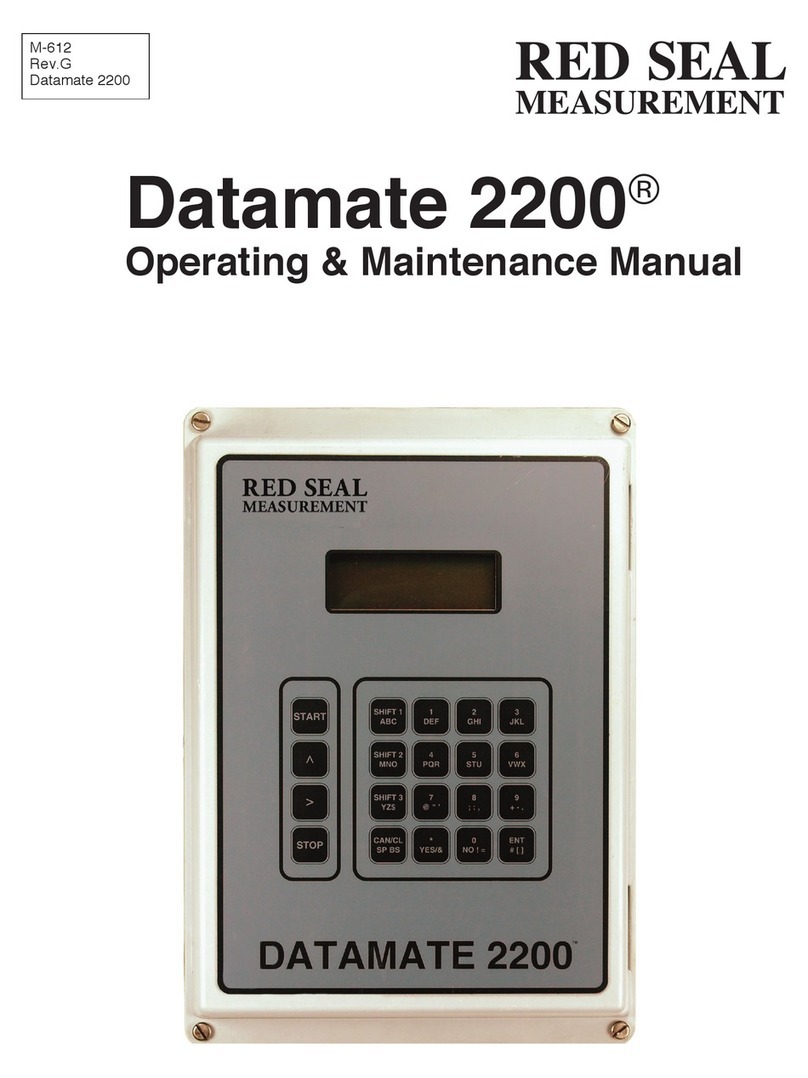
Red Seal Measurement
Red Seal Measurement Datamate 2200 operating & maintenance manual
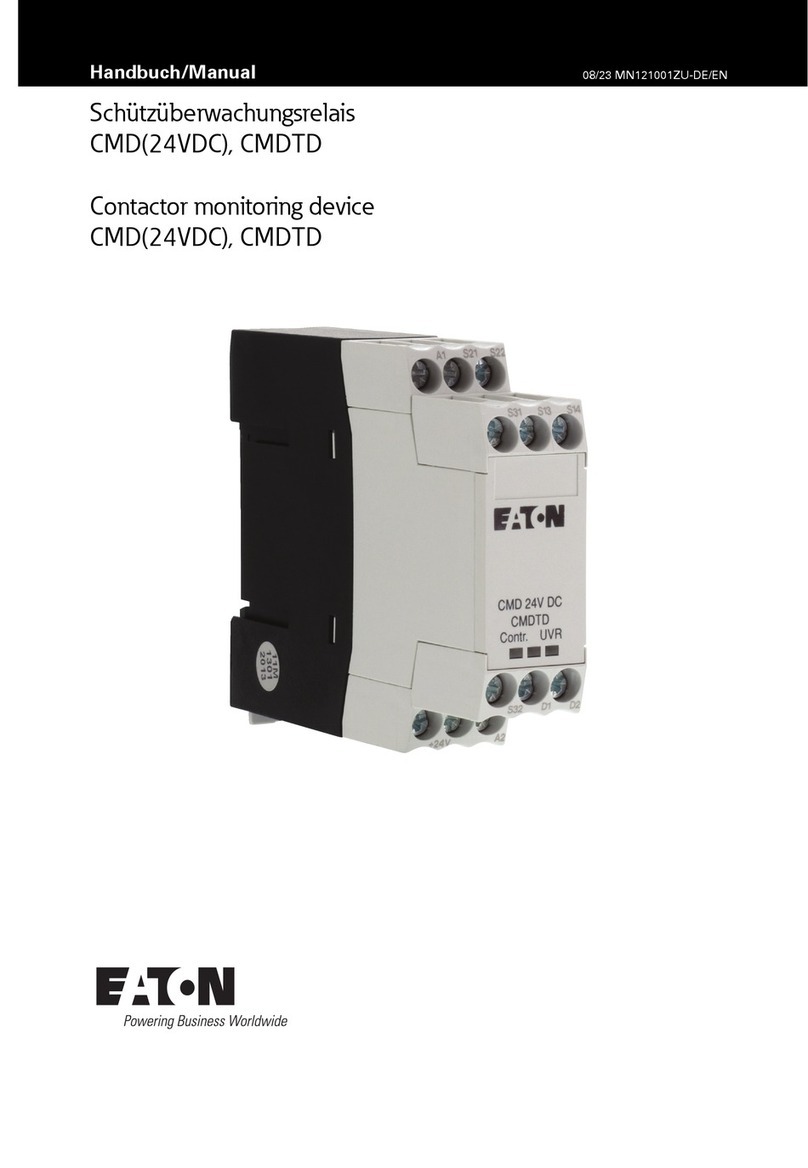
Eaton
Eaton CMD(24VDC) manual
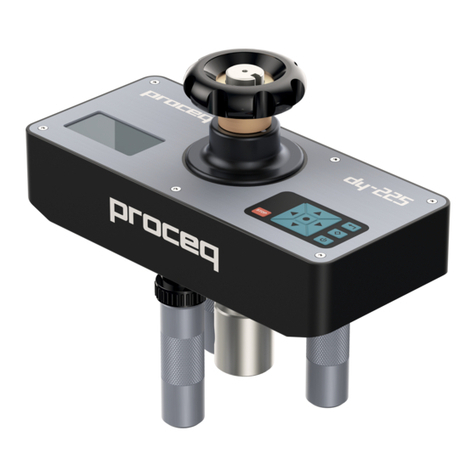
Proceq
Proceq DY-2 series operating instructions
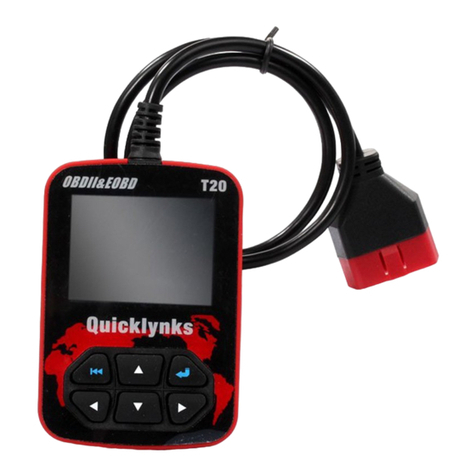
Quicklynks
Quicklynks T20 user manual

Avid Technology
Avid Technology Z Series Installation and operation manual

Sekonic
Sekonic TWINMATE L-208 operating instructions
